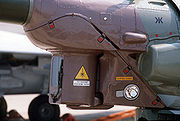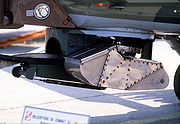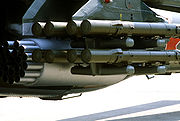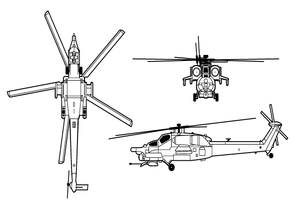
Mil Mi-28
Encyclopedia
The Mil
Mil Moscow Helicopter Plant
Mil Helicopters is the short name of the Soviet Russian helicopter producer Mil Moscow Helicopter Plant , named after the constructor Mikhail Mil. Mil participates in the Euromil joint venture with Eurocopter....
Mi-28 (NATO reporting name
NATO reporting name
NATO reporting names are classified code names for military equipment of the Eastern Bloc...
'Havoc') is a Russian all-weather day-night military tandem two-seat anti-armour attack helicopter
Attack helicopter
An attack helicopter is a military helicopter with the primary role of an attack aircraft, with the capability of engaging targets on the ground, such as enemy infantry and armored vehicles...
. It is a dedicated attack helicopter with no intended secondary transport capability, better optimized than the Mil Mi-24
Mil Mi-24
The Mil Mi-24 is a large helicopter gunship and attack helicopter and low-capacity troop transport with room for 8 passengers. It is produced by Mil Moscow Helicopter Plant and operated since 1972 by the Soviet Air Force, its successors, and by over thirty other nations.In NATO circles the export...
for the role. It carries a single gun in an undernose barbette, plus external loads carried on pylons beneath stub wings.
Development
In 1972, following completion of the Mil Mi-24Mil Mi-24
The Mil Mi-24 is a large helicopter gunship and attack helicopter and low-capacity troop transport with room for 8 passengers. It is produced by Mil Moscow Helicopter Plant and operated since 1972 by the Soviet Air Force, its successors, and by over thirty other nations.In NATO circles the export...
, development began on a unique attack helicopter with transport capability. The new design had a reduced transport capability (3 troops instead of 8) and omitted the cabin, to provide better overall performance and higher top speed. Improved performance was important for its intended role fighting against tanks and enemy helicopters and covering helicopter landing operations. Initially, many different designs were considered, including an unconventional project with two main rotors, placed with engines on tips of wings (in perpendicular layout), and with an additional pusher
Pusher configuration
In a craft with a pusher configuration the propeller are mounted behind their respective engine. According to Bill Gunston, a "pusher propeller" is one mounted behind engine so that drive shaft is in compression...
propeller on the tail. In 1977, a preliminary design was chosen, in a classic single-rotor layout. It lost its similarity to the Mi-24, and even the canopies were smaller, with flat surfaces.
Design work began on the Mi-28 began under Marat Tishchenko in 1980. In 1981, a design and a mock-up were accepted. The prototype (no. 012) was first flown on 10 November 1982. The second prototype (no. 022) was completed in 1983. In 1984, the Mi-28 completed the first stage of state trials, but in October 1984 the Soviet Air Force
Soviet Air Force
The Soviet Air Force, officially known in Russian as Военно-воздушные силы or Voenno-Vozdushnye Sily and often abbreviated VVS was the official designation of one of the air forces of the Soviet Union. The other was the Soviet Air Defence Forces...
chose the more advanced Kamov Ka-50
Kamov Ka-50
The Kamov Ka-50 "Black Shark" is a single-seat Russian attack helicopter with the distinctive coaxial rotor system of the Kamov design bureau. It was designed in the 1980s and adopted for service in the Russian army in 1995...
as the new anti-tank helicopter. The Mi-28 development was continued, but given lower priority. In December 1987 Mi-28 production in Rosvertol in Rostov on Don was approved.
In January 1988 the first Mi-28A prototype (no. 032) flew. It was fitted with more powerful engines and an "X" type tail rotor instead of the three-blade version. The Mi-28A debuted at the Paris Air Show
Paris Air Show
The Paris Air Show is the world's oldest and largest air show. Established in 1909, it is currently held every odd year at Le Bourget Airport in north Paris, France...
in June 1989. In 1991 the second Mi-28A (no. 042) was completed. The Mi-28A program was cancelled in 1993 because it was deemed uncompetitive with the Ka-50, and in particular, it was not all-weather capable.

Radar
Radar is an object-detection system which uses radio waves to determine the range, altitude, direction, or speed of objects. It can be used to detect aircraft, ships, spacecraft, guided missiles, motor vehicles, weather formations, and terrain. The radar dish or antenna transmits pulses of radio...
in a round cover above the main rotor, similar to that of the American AH-64D Longbow Apache. Mi-28N also has improved Tor vision and an aiming device under the nose, including a TV camera and FLIR. Due to funding problems, development was interrupted. A second prototype with an improved rotor design was unveiled in March 2004 at Rosvertol.
Changes in the military situation after the Cold War
Cold War
The Cold War was the continuing state from roughly 1946 to 1991 of political conflict, military tension, proxy wars, and economic competition between the Communist World—primarily the Soviet Union and its satellite states and allies—and the powers of the Western world, primarily the United States...
made specialized anti-tank helicopters, like Ka-50, less useful. On the other hand, its all-weather, two-seat variant Ka-52 had worse performance due to increased weight. The advantages of the Mi-28N, like all-weather action ability, lower cost, and similarity to the Mi-24, have become important. In 2003, the head of Russian Air Forces stated that the Mi-28N will become the standard Russian attack helicopter.

An export variant of the Mi-28N, designated Mi-28NE, and a simpler day-helicopter variant, the Mi-28D, based on the Mi-28N design, but lacking radar and FLIR have also been developed.
Design
The Mi-28 has two heavily armored cockpits, a windshield able to withstand hits from 7.62–12.7 mm caliber bullets, a nose equipped with electronics, and a narrow-X tail rotor (55 deg) with reduced noise characteristics. It is powered by two 2,200 hp Isotov TV-3-117VM (t/n 014) turboshaftTurboshaft
A turboshaft engine is a form of gas turbine which is optimized to produce free turbine shaft power, rather than jet thrust...
engines.
While the Mi-28 is not intended for use as a transport, it does have a small passenger compartment capable of carrying three people. The planned purpose of this is to enable the rescue of downed helicopter crews.
The Mi-28N features a helmet mounted display
Helmet mounted display
A helmet mounted display is a device used in some modern aircraft, especially combat aircraft. HMDs project information similar to that of head-up displays on an aircrew’s visor or reticle, thereby allowing him to obtain situational awareness and/or cue weapons systems to the direction his head...
for the pilot. The pilot would designate targets for the Navigator/Weapons Officer, who proceeds to fire the weapons required to fulfill that particular task.
Armament
One armament that is commonly seen amongst Mi-28s are a pair of 8 Ataka9M120 Ataka-V
The AT-9 Spiral-2 is the NATO reporting name for the 9M120 Ataka-V SACLOS radio guided anti-tank missile system of the Soviet Union. It is the next major generation in the 9K114 Shturm family...
missile racks along with 2 B-13L rocket pods, each able to carry 5 S-13 rocket
S-13 rocket
The S-13 is a 122 mm calibre unguided rocket weapon developed by the Soviet Air Force for use by military aircraft. It remains in service with the Russian Air Force and some other countries....
s. Other rocket options include two B-8 rocket pods, each able to carry up to 20 S-8 rocket
S-8 rocket
The S-8 is a rocket weapon developed by the Soviet Air Force for use by military aircraft. It remains in service with the Russian Air Force and various export customers....
s. The 30 mm chain gun is a staple amongst all Mi-28 combat loads.
The Atakas used have 4 variants for different tasks. The 9M120 Tandem
Tandem-charge
A tandem-charge weapon is an explosive device or projectile that has two or more stages of detonation. It is effective against cage armor, which is designed to protect an armored vehicle against anti-tank munitions. The first stage of the weapon triggers the reactive armor of the target, limiting...
High Explosive Anti-Tank (HEAT) warhead variant is used against tank
Tank
A tank is a tracked, armoured fighting vehicle designed for front-line combat which combines operational mobility, tactical offensive, and defensive capabilities...
s fitted with Explosive Reactive Armor (ERA)
Reactive armour
Reactive armour is a type of vehicle armour that reacts in some way to the impact of a weapon to reduce the damage done to the vehicle being protected. It is most effective in protecting against shaped charges and specially hardened long rod penetrators...
, its penetrative ability is stated at 800 mm Rolled Homogeneous Armour (RHA)
Rolled homogeneous armour
Rolled homogeneous armour is a type of steel which is used to armour vehicles.-Composition:Armoured steel must be hard yet impervious to shock in order to resist high velocity metal projectiles. Steel with these characteristics is produced by processing cast steel billets of appropriate size and...
. The 9M120F Thermobaric variant is used against infantry
Infantry
Infantrymen are soldiers who are specifically trained for the role of fighting on foot to engage the enemy face to face and have historically borne the brunt of the casualties of combat in wars. As the oldest branch of combat arms, they are the backbone of armies...
, buildings, bunkers, and caves. The 9M120O expanding rod
Continuous-rod warhead
A continuous-rod warhead is a specialized munition that exhibits an annular blast fragmentation pattern. It is used in anti-aircraft and anti-missile missiles.-Early anti-aircraft munitions:...
warhead variant is used against other helicopters. All the variants have a range of 6 km. The 9M120M improved version has a longer range (8 km) and better penetration (900 mm of RHA). All of the variants use SACLOS
SACLOS
SACLOS is an acronym for Semi-Automatic Command to Line of Sight, a second-generation method of missile guidance. In SACLOS, the operator has to continually point a sighting device at the target while the missile is in flight...
missile guidance.
The S-8 and S-13 rockets used by the Mi-28 are usually unguided. In the most common configuration, one can expect 40 S-8 rockets or 10 S-13 rockets. Both rockets have their variants, from HEAT warheads to a Thermobaric warhead. The S-8 has a shorter range and smaller warhead than the S-13, but compensates with numbers. Currently, the Russian Air Force
Russian Air Force
The Russian Air Force is the air force of Russian Military. It is currently under the command of Colonel General Aleksandr Zelin. The Russian Navy has its own air arm, the Russian Naval Aviation, which is the former Soviet Aviatsiya Voyenno Morskogo Flota , or AV-MF).The Air Force was formed from...
are upgrading their S-8 and S-13 rockets to laser guided missiles with the proposed Ugroza
Ugroza
Ugroza is a precision-guided weapons system made in Russian Federation. It is an upgrade for standard Russian "dumb" rockets, including the S-5, S-8, and S-13 rockets. The system upgrades the "dumb" rockets with laser guidance, very significantly increasing their accuracy. It requires a laser...
("Menace") system. Rockets upgraded under Ugroza would receive designations S-8Kor and S-13Kor, respectively.
The gun armament of the Mi-28 is the 30 x 165 mm
30 mm caliber
30 mm caliber ammunition is usually used in autocannon. Such ammunition includes NATO standard 30 × 173 mm and 30 × 113 mm and Soviet 30 × 165 mm ammunition widely used around the world....
Shipunov 2A42
30 mm automatic cannon 2A42
The 30 mm automatic cannon 2A42, also known as the Shipunov 2A42, is a Soviet/Russian 30 mm automatic cannon. It is built by the Tulamashzavod Joint Stock Company.-Design:...
Autocannon
Autocannon
An autocannon or automatic cannon is a rapid-fire projectile weapon firing a shell as opposed to the bullet fired by a machine gun. Autocannons often have a larger caliber than a machine gun . Usually, autocannons are smaller than a field gun or other artillery, and are mechanically loaded for a...
. It is a select fire, dual-feed gun, which allows for a cyclic rate of fire between 200 rounds per minute to 550 rounds per minute. Its effective range varies from 1500 meters for ground vehicles to 2500 meters for air targets. Rounds from High Explosive Incendiary (HEI)
High explosive incendiary
In warfare, High-explosive incendiary is a type of ammunition specially designed to pierce armor, fragment, and ignite readily combustible materials....
to Armour-Piercing Discarding Sabot (APDS)
Armour-piercing discarding sabot
Armour-piercing discarding sabot is a type of kinetic energy projectile fired from a gun to attack armoured targets. APDS rounds are sabot rounds and were commonly used in large calibre tank guns, but have now been superseded by armour-piercing fin-stabilized discarding sabot projectiles in such...
can be used. Stated penetration for the 3UBR8 is 50 mm of RHA at 1,500 meters.
Operational history
The Russian Army received the first Mi-28 prototypes for testing in 2004. It received the first serial production Mi-28N in 2006. That serial Mi-28N then joined two prototype helicopters for army trials. The aircraft entered service in 2006. A total of 24 Mi-28s were in service with the Russian Air Force as of February 2011.On 15 February 2011 a Mi-28 crashed in southern Russian region of Stavropol. One of the pilots later died in hospital.
Export interest
The Indian Military asked for a modified prototype of Mi-28 fitted with French and Belgian avionics. Russian manufacturers are discussing how to meet these requirements. There are reports of negotiations with IAF on the Mi-28 and the Boeing AH-64D for 22 attack helicopters.Variants

- Mi-28A – Original production anti-tank helicopter. Development done in 1998, first flight in 2003.
- Mi-28N/MMW Havoc – All weather day-and-night combat helicopter. It is equipped with a top-mounted millimeter wave radar station, IR-TV, and laser ranger. Serial Mi-28N will have two Russian Klimov TV3-117V MA-SB3 engines (2,500 hp each), made in production by the Ukrainian Motor-SichMotor-SichThe Motor Sich Public Joint Stock Company in Zaporizhia is among the largest engine manufactures for airplanes and helicopters worldwide. It also is the only enterprise in Ukraine manufacturing engines for airplanes and helicopters as well as industrial gas turbine installations...
. Max take off weight of 11500 kg, max payload weight of 2,350 kg.- Mi-28N has entered service under the name of "Night Hunter" . A squadron of Mi-28N from TorzhokTorzhokTorzhok is a town in Tver Oblast, Russia, famous for its folk craft of goldwork embroidery. Population: Torzhok has twenty-two large and medium-sized industrial enterprises. Two of them are especially significant...
town has taken part in the joint army exercise in Belorussia in June 2006.
- Mi-28N has entered service under the name of "Night Hunter" . A squadron of Mi-28N from Torzhok
- Mi-28D – simplified daylight operation version. Similar to Mi-28N, but without top-mounted radar and TV-channel in sight.
- Mi-28NAe – export version offered to North KoreaNorth KoreaThe Democratic People’s Republic of Korea , , is a country in East Asia, occupying the northern half of the Korean Peninsula. Its capital and largest city is Pyongyang. The Korean Demilitarized Zone serves as the buffer zone between North Korea and South Korea...
. - Mi-28L – proposed export version for IraqIraqIraq ; officially the Republic of Iraq is a country in Western Asia spanning most of the northwestern end of the Zagros mountain range, the eastern part of the Syrian Desert and the northern part of the Arabian Desert....
. - Mi-40Mil Mi-40The Mil Mi-40 was a projected utility version of the Mil Mi-28, first initiated in 1983, announced in 1992 and shown at the Moscow Airshow in 1993...
– armed transport version.
Operators
- Russian Air ForceRussian Air ForceThe Russian Air Force is the air force of Russian Military. It is currently under the command of Colonel General Aleksandr Zelin. The Russian Navy has its own air arm, the Russian Naval Aviation, which is the former Soviet Aviatsiya Voyenno Morskogo Flota , or AV-MF).The Air Force was formed from...
had 44 in operation http://www.armstrade.org/includes/periodics/news/2011/1012/10109945/detail.shtml- 344th Centre for Combat Training and Flight Personnel Training, TorzhokTorzhokTorzhok is a town in Tver Oblast, Russia, famous for its folk craft of goldwork embroidery. Population: Torzhok has twenty-two large and medium-sized industrial enterprises. Two of them are especially significant...
- 55th Independent Helicopter Regiment, KorenovskKorenovskKorenovsk is a town and the administrative center of Korenovsky District of Krasnodar Krai, Russia, located on the Beysuzhyok Levy River northeast of Krasnodar. Population:...
, has been reported to be the first planned operational unit - 118th Helicopter Regiment – Dmitriyevka, Oblast
- 344th Centre for Combat Training and Flight Personnel Training, Torzhok
- Algerian Air ForceAlgerian Air ForceThe Algerian Air Force is the aerial arm of the Algerian People's Military.- Inventory :- External links : http://www.algaf.bravehost.com/index.htm http://www.avions-militaires.net/dossiers/armee-air/dza.php...
was expected to place an order for 42 Mi-28NE helicopters as of June 2010.
- Venezuelan Air Force had 10 Mi-28N/MMW on order in April 2010, delivery date unknown.
- Soviet Air ForceSoviet Air ForceThe Soviet Air Force, officially known in Russian as Военно-воздушные силы or Voenno-Vozdushnye Sily and often abbreviated VVS was the official designation of one of the air forces of the Soviet Union. The other was the Soviet Air Defence Forces...
– Mi-28s passed onto Russian Air ForceRussian Air ForceThe Russian Air Force is the air force of Russian Military. It is currently under the command of Colonel General Aleksandr Zelin. The Russian Navy has its own air arm, the Russian Naval Aviation, which is the former Soviet Aviatsiya Voyenno Morskogo Flota , or AV-MF).The Air Force was formed from...
Specifications (Mi-28N)


